The Your browser has been blocked based on your security preferences is a misleading advertising that created in order to force you into calling a fake Microsoft Support service. If your browser opens automatically to this site then it is possible that your system has become a victim of malicious program from the adware family. It is a type of harmful software that designed to display a lot of intrusive popup ads. Unlike viruses, the adware will not delete or infect your files, but its actions will cause some problems with your browser. This is because, it will infect your machine, get full access to your web-browsers such as Chrome, Mozilla Firefox, Edge and Internet Explorer and can be used to alter their settings. Of course, it did not ask you for permission and do it secretly as possible. Once your browser settings will be modified, you will be redirected to undesired ads, some of which can lead to malicious or misleading webpages. For this reason, we suggest that you start the clean up of your system ASAP and thus get rid of “Your Browser Has Been Blocked” fake alerts from your internet browser.
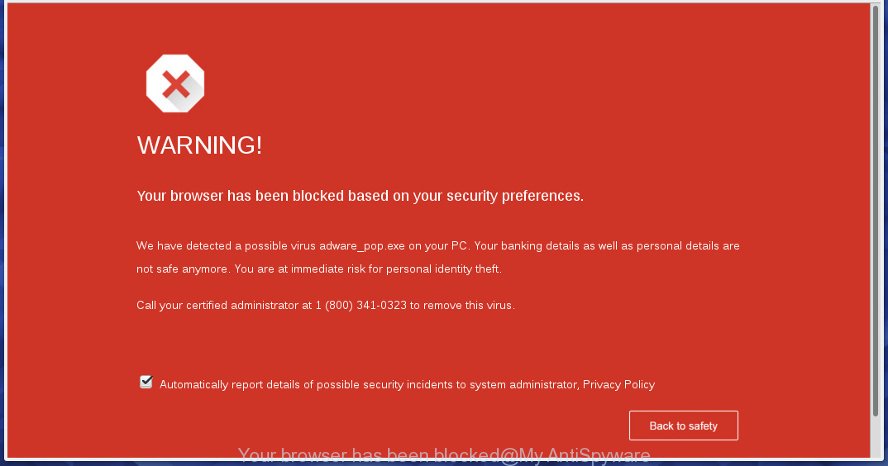
The “Your browser has been blocked” is a misleading advertising
The full text of the “Your browser has been blocked” alert is:
WARNING! Your browser has been blocked based on your security preferences We have detected a possible virus adware_pop.exe on your PC. Your banking details as well as personal details are not safe anymore. You are at immediate risk for personal identity theft. Call your certified administrator at xxx to remove this virus. Automatically report details of possible security incidents to system administrator, Privacy policy
The ad-supported software which causes misleading “Your Browser Has Been Blocked” fake alerts on your web-browser, may inject lots of ads directly to the pages that you visit, creating a sense that the advertising links have been added by the creators of the web page. Moreover, a legal sponsored links may be replaced on the fake ads, that will offer to download and install various unnecessary and harmful applications. The worst is, the adware can collect lots of your user info (your ip address, what is a webpage you are viewing now, what you are looking for on the Web, which links you are clicking), which can later transfer to third parties.
The malicious apps from the ad-supported software family that alters the settings of browsers usually infects only the Mozilla Firefox, Google Chrome, Edge and Internet Explorer. However, possible situations, when any other web-browsers will be infected too. The ‘ad supported’ software may modify the Target property of a browser’s shortcut, so every time you open the internet browser, instead of your homepage, you will see the annoying “Your Browser Has Been Blocked” webpage.
So, obviously, you need to get rid of the adware immediately. Use the free step-by-step instructions below. This guide will help you clean your PC of ad supported software and thus get rid of the “Your Browser Has Been Blocked” undesired pop-up ads.
Remove “Your Browser Has Been Blocked” pop up scam (removal tutorial)
In order to get rid of “Your Browser Has Been Blocked” pop-up from the Google Chrome, Microsoft Edge, Microsoft Internet Explorer and Firefox, you need to reset the internet browser settings. Additionally, you should look up for other dubious entries, such as files, programs, internet browser plugins and shortcut files. However, if you want to remove “Your Browser Has Been Blocked” popup scam easily, you should run reputable antimalware tool and let it do the job for you.
To remove “Your Browser Has Been Blocked”, use the following steps:
- Remove “Your Browser Has Been Blocked” popup scam without any utilities
- Remove potentially unwanted software using Windows Control Panel
- Remove “Your Browser Has Been Blocked” from Firefox by resetting web browser settings
- Remove “Your Browser Has Been Blocked” pop up from Chrome
- Remove “Your Browser Has Been Blocked” fake alerts from Internet Explorer
- Get rid of unwanted Scheduled Tasks
- Fix web browser shortcuts, altered by ad supported software
- Run free malware removal tools to completely delete “Your Browser Has Been Blocked” fake alerts
- Stop “Your Browser Has Been Blocked” popup and other undesired webpages
- How did you get infected with “Your Browser Has Been Blocked” popup scam
- Finish words
Remove “Your Browser Has Been Blocked” popup scam without any utilities
If you perform exactly the step-by-step guidance below you should be able to get rid of the “Your Browser Has Been Blocked” popup scam from the Microsoft Internet Explorer, Firefox, Chrome and Microsoft Edge web browsers.
Remove potentially unwanted software using Windows Control Panel
Check out the MS Windows Control Panel (Programs and Features section) to see all installed programs. We recommend to click on the “Date Installed” in order to sort the list of apps by the date you installed them. If you see any unknown and dubious programs, they are the ones you need to uninstall.
Press Windows button ![]() , then click Search
, then click Search ![]() . Type “Control panel”and press Enter. If you using Windows XP or Windows 7, then click “Start” and select “Control Panel”. It will show the Windows Control Panel as shown on the image below.
. Type “Control panel”and press Enter. If you using Windows XP or Windows 7, then click “Start” and select “Control Panel”. It will show the Windows Control Panel as shown on the image below.

Further, press “Uninstall a program” ![]()
It will show a list of all software installed on your PC. Scroll through the all list, and delete any suspicious and unknown programs.
Remove “Your Browser Has Been Blocked” from Firefox by resetting web browser settings
Resetting Mozilla Firefox internet browser will reset all the settings to their original state and will remove “Your Browser Has Been Blocked” fake alerts, malicious add-ons and extensions. Essential information like bookmarks, browsing history, passwords, cookies, auto-fill data and personal dictionaries will not be removed.
Press the Menu button (looks like three horizontal lines), and click the blue Help icon located at the bottom of the drop down menu as on the image below.

A small menu will appear, click the “Troubleshooting Information”. On this page, click “Refresh Firefox” button as displayed below.

Follow the onscreen procedure to restore your Mozilla Firefox web browser settings to their default values.
Remove “Your Browser Has Been Blocked” pop up from Chrome
Like other modern web-browsers, the Chrome has the ability to reset the settings to their default values and thereby recover the internet browser’s settings like search engine by default, start page and new tab page that have been changed by the ‘ad supported’ software which developed to show misleading “Your Browser Has Been Blocked” pop-up scam within your internet browser.
First open the Google Chrome. Next, click the button in the form of three horizontal dots (![]() ).
).
It will display the Google Chrome menu. Choose More Tools, then click Extensions. Carefully browse through the list of installed add-ons. If the list has the extension signed with “Installed by enterprise policy” or “Installed by your administrator”, then complete the following tutorial: Remove Google Chrome extensions installed by enterprise policy.
Open the Google Chrome menu once again. Further, press the option called “Settings”.

The browser will show the settings screen. Another solution to show the Google Chrome’s settings – type chrome://settings in the web browser adress bar and press Enter
Scroll down to the bottom of the page and click the “Advanced” link. Now scroll down until the “Reset” section is visible, as on the image below and click the “Reset settings to their original defaults” button.

The Google Chrome will open the confirmation dialog box as shown below.

You need to confirm your action, click the “Reset” button. The internet browser will launch the task of cleaning. After it’s done, the browser’s settings including search engine by default, newtab page and start page back to the values which have been when the Google Chrome was first installed on your computer.
Remove “Your Browser Has Been Blocked” fake alerts from Internet Explorer
By resetting Internet Explorer internet browser you revert back your internet browser settings to its default state. This is good initial when troubleshooting problems that might have been caused by adware which displays misleading “Your Browser Has Been Blocked” fake alerts on your system.
First, start the Internet Explorer. Next, click the button in the form of gear (![]() ). It will show the Tools drop-down menu, press the “Internet Options” as on the image below.
). It will show the Tools drop-down menu, press the “Internet Options” as on the image below.

In the “Internet Options” window click on the Advanced tab, then click the Reset button. The Microsoft Internet Explorer will show the “Reset Internet Explorer settings” window as shown below. Select the “Delete personal settings” check box, then click “Reset” button.

You will now need to reboot your machine for the changes to take effect.
Get rid of unwanted Scheduled Tasks
Once installed, the adware can add a task in to the Windows Task Scheduler Library. Due to this, every time when you start your machine, it will open “Your Browser Has Been Blocked” annoying site. So, you need to check the Task Scheduler Library and delete all malicious tasks that have been created by unwanted programs.
Press Windows and R keys on the keyboard together. This displays a prompt that titled with Run. In the text field, type “taskschd.msc” (without the quotes) and click OK. Task Scheduler window opens. In the left-hand side, click “Task Scheduler Library”, as on the image below.
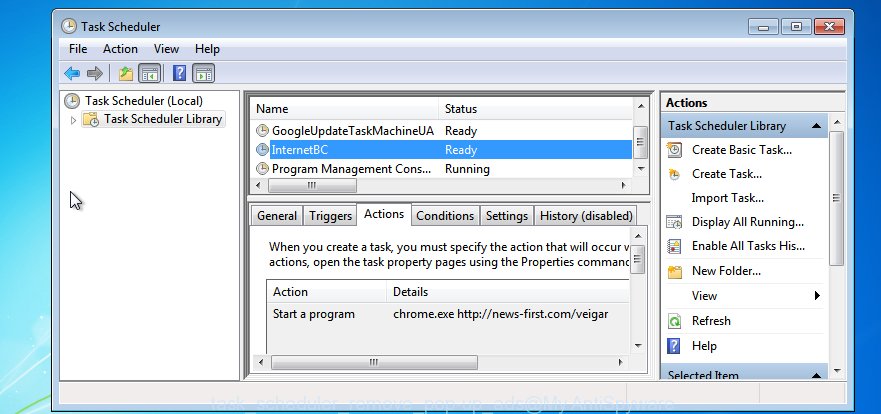
Task scheduler
In the middle part you will see a list of installed tasks. Please select the first task, its properties will be show just below automatically. Next, click the Actions tab. Pay attention to that it launches on your machine. Found something like “explorer.exe http://site.address” or “chrome.exe http://site.address”, then get rid of this malicious task. If you are not sure that executes the task, check it through a search engine. If it is a component of the ‘ad-supported’ program, then this task also should be removed.
Having defined the task that you want to delete, then press on it with the right mouse button and select Delete as displayed below.

Delete a task
Repeat this step, if you have found a few tasks that have been created by malicious programs. Once is finished, close the Task Scheduler window.
Fix web browser shortcuts, altered by ad supported software
Unfortunately, the adware which causes misleading “Your Browser Has Been Blocked” popup on your web-browser, can also hijack Windows shortcuts (mostly, your internet browsers shortcut files), so that the “Your Browser Has Been Blocked” ad web site will be shown when you open the Chrome, Edge, Mozilla Firefox and Microsoft Internet Explorer or another web-browser.
Right click on the internet browser’s shortcut file, click Properties option. On the Shortcut tab, locate the Target field. Click inside, you will see a vertical line – arrow pointer, move it (using -> arrow key on your keyboard) to the right as possible. You will see a text “http://site.address” which has been added here. Remove everything after .exe. An example, for Google Chrome you should remove everything after chrome.exe.

To save changes, click OK . You need to clean all web-browser’s shortcut files. So, repeat this step for the IE, Edge, Mozilla Firefox and Chrome.
Run free malware removal tools to completely delete “Your Browser Has Been Blocked” fake alerts
The adware can hide its components which are difficult for you to find out and delete completely. This can lead to the fact that after some time, the ad supported software that made to display misleading “Your Browser Has Been Blocked” pop up warnings within your internet browser again infect your computer. Moreover, We want to note that it’s not always safe to remove adware manually, if you do not have much experience in setting up and configuring the MS Windows operating system. The best method to search for and remove ad supported software is to run free malware removal applications.
How to automatically get rid of “Your Browser Has Been Blocked” pop up warnings with Zemana Anti-malware
Zemana Anti-malware is a tool that can remove ad-supported software, PUPs, browser hijackers and other malware from your machine easily and for free. Zemana Anti-malware is compatible with most antivirus software. It works under Windows (10 – XP, 32 and 64 bit) and uses minimum of system resources.
Download Zemana Anti-Malware (ZAM) on your computer by clicking on the link below.
164777 downloads
Author: Zemana Ltd
Category: Security tools
Update: July 16, 2019
After the downloading process is complete, close all windows on your system. Further, start the install file called Zemana.AntiMalware.Setup. If the “User Account Control” dialog box pops up as displayed on the image below, press the “Yes” button.

It will display the “Setup wizard” that will help you install Zemana on the computer. Follow the prompts and do not make any changes to default settings.

Once installation is finished successfully, Zemana Anti Malware (ZAM) will automatically launch and you can see its main window as shown on the screen below.

Next, click the “Scan” button . Zemana AntiMalware (ZAM) program will scan through the whole personal computer for the ‘ad supported’ software which cause misleading “Your Browser Has Been Blocked” fake alerts to appear. This task can take quite a while, so please be patient.

When Zemana has finished scanning your personal computer, the results are displayed in the scan report. Review the report and then click “Next” button.

The Zemana Free will remove adware which made to show misleading “Your Browser Has Been Blocked” fake alerts within your browser. After the task is finished, you may be prompted to reboot your personal computer.
Scan and free your machine of adware with Hitman Pro
Hitman Pro is a portable utility that identifies and deletes unwanted applications such as browser hijacker infections, adware, toolbars, other browser extensions and other malicious software. It scans your personal computer for adware that developed to show misleading “Your Browser Has Been Blocked” popup scam within your web browser and produces a list of items marked for removal. Hitman Pro will only erase those unwanted software that you wish to be removed.
Visit the page linked below to download Hitman Pro. Save it on your Desktop.
Once the download is done, open the file location and double-click the Hitman Pro icon. It will run the HitmanPro tool. If the User Account Control dialog box will ask you want to launch the program, press Yes button to continue.
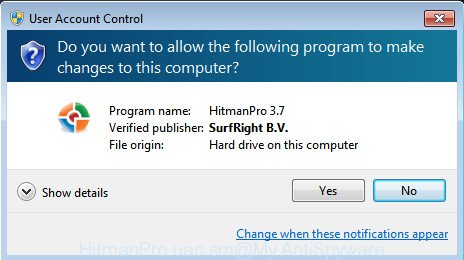
Next, press “Next” for checking your computer for the adware that shows misleading “Your Browser Has Been Blocked” pop up scam on your personal computer. This procedure may take some time, so please be patient. When a malware, adware or PUPs are found, the count of the security threats will change accordingly.
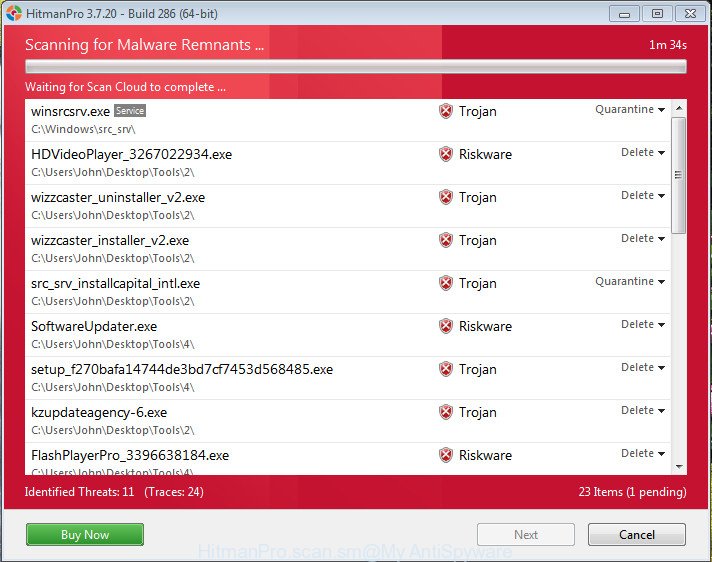
When the scanning is finished, Hitman Pro will open you the results as shown on the image below.
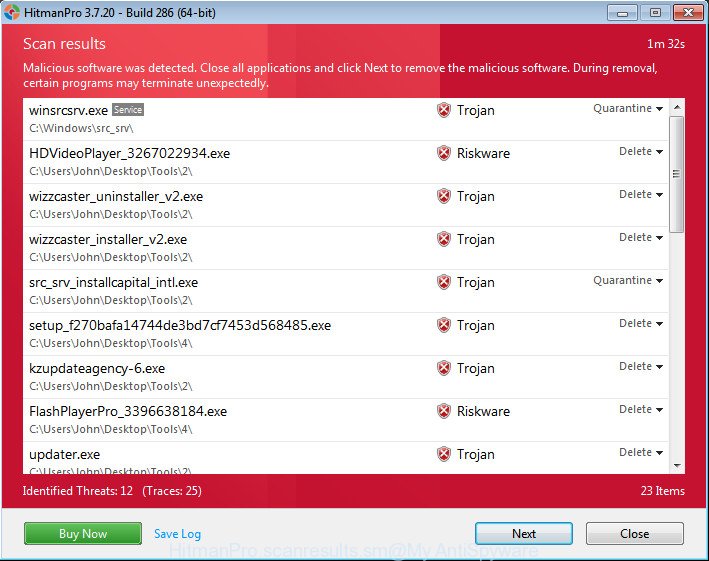
You may remove items (move to Quarantine) by simply click “Next” button. It will open a prompt, press the “Activate free license” button. The Hitman Pro will delete adware which shows misleading “Your Browser Has Been Blocked” pop-up scam on your computer and add threats to the Quarantine. When finished, the tool may ask you to restart your machine.
How to remove “Your Browser Has Been Blocked” with Malwarebytes
You can delete “Your Browser Has Been Blocked” pop-up automatically with a help of Malwarebytes Free. We recommend this free malicious software removal utility because it can easily get rid of browser hijackers, ‘ad supported’ software, PUPs and toolbars with all their components such as files, folders and registry entries.
Please go to the link below to download MalwareBytes Anti Malware. Save it to your Desktop so that you can access the file easily.
327038 downloads
Author: Malwarebytes
Category: Security tools
Update: April 15, 2020
When downloading is complete, close all applications and windows on your system. Double-click the install file called mb3-setup. If the “User Account Control” prompt pops up as displayed in the figure below, click the “Yes” button.

It will open the “Setup wizard” which will help you install MalwareBytes AntiMalware on your machine. Follow the prompts and do not make any changes to default settings.
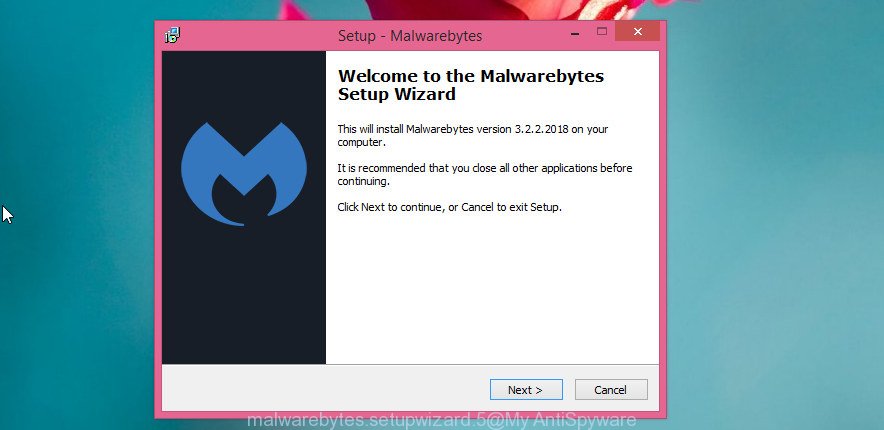
Once install is complete successfully, press Finish button. MalwareBytes AntiMalware will automatically start and you can see its main screen as shown in the following example.
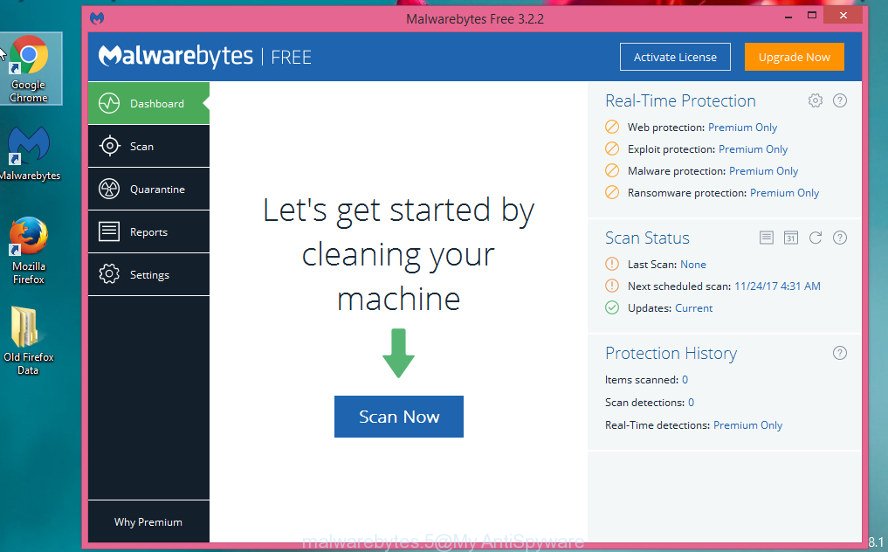
Now press the “Scan Now” button . MalwareBytes Free utility will begin scanning the whole computer to find out adware which cause misleading “Your Browser Has Been Blocked” pop up scam to appear. This task can take quite a while, so please be patient. During the scan MalwareBytes will look for threats present on your PC.
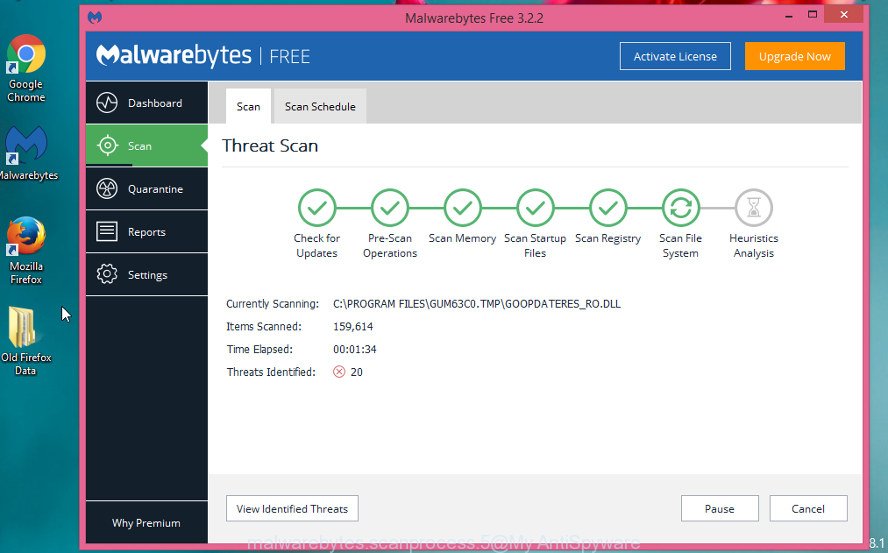
After the scanning is finished, you can check all items detected on your PC. Make sure all threats have ‘checkmark’ and click “Quarantine Selected” button. The MalwareBytes will delete ad supported software that causes web browsers to display misleading “Your Browser Has Been Blocked” fake alerts and add threats to the Quarantine. Once that process is complete, you may be prompted to reboot the machine.

We recommend you look at the following video, which completely explains the process of using the MalwareBytes to remove ‘ad supported’ software, hijacker and other malicious software.
Stop “Your Browser Has Been Blocked” popup and other undesired webpages
To put it simply, you need to use an ad-blocker utility (AdGuard, for example). It will stop and protect you from all undesired web pages such as “Your Browser Has Been Blocked”, ads and pop-ups. To be able to do that, the adblocker program uses a list of filters. Each filter is a rule that describes a malicious web-site, an advertising content, a banner and others. The ad blocking program automatically uses these filters, depending on the web pages you’re visiting.
- Installing the AdGuard is simple. First you will need to download AdGuard from the following link. Save it to your Desktop so that you can access the file easily.
Adguard download
26839 downloads
Version: 6.4
Author: © Adguard
Category: Security tools
Update: November 15, 2018
- After the download is done, start the downloaded file. You will see the “Setup Wizard” program window. Follow the prompts.
- After the installation is finished, click “Skip” to close the install program and use the default settings, or click “Get Started” to see an quick tutorial that will help you get to know AdGuard better.
- In most cases, the default settings are enough and you don’t need to change anything. Each time, when you launch your personal computer, AdGuard will start automatically and block unwanted ads, “Your Browser Has Been Blocked” pop-ups, as well as other harmful or misleading pages. For an overview of all the features of the program, or to change its settings you can simply double-click on the icon named AdGuard, which is located on your desktop.
How did you get infected with “Your Browser Has Been Blocked” popup scam
It is very important to pay attention to additional checkboxes during the installation of freeware to avoid installing of potentially unwanted apps, ad supported software, browser hijacker infections or other undesired software. Never install the optional software that the application wants to install with it. Inattentive freeware download can result in installation of undesired program like this ad supported software that made to display misleading “Your Browser Has Been Blocked” pop up within your internet browser.
Finish words
Now your personal computer should be clean of the ‘ad supported’ software which made to show misleading “Your Browser Has Been Blocked” pop-up within your browser. We suggest that you keep AdGuard (to help you block unwanted advertisements and intrusive harmful web-sites) and Zemana Free (to periodically scan your PC system for new malware, hijackers and adware). Make sure that you have all the Critical Updates recommended for Windows OS. Without regular updates you WILL NOT be protected when new hijackers, malicious apps and adware are released.
If you are still having problems while trying to delete “Your Browser Has Been Blocked” pop-up scam from your web-browser, then ask for help in our Spyware/Malware removal forum.




















